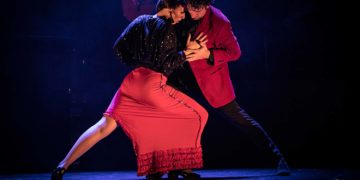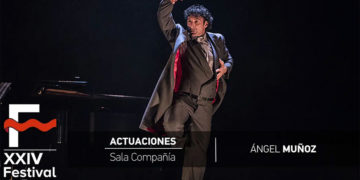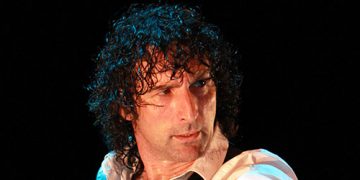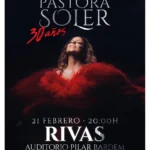|
XV FESTIVAL DE JEREZ |
|
Text: Estela Zatania NAZARET CALA, KIKO PEÑA A new generation singers is coming up to fill the huge vacuum left by recent losses of classic voices like Chocolate, Paquera de Jerez, Fernanda and Bernarda de Utrera or Chano Lobato. These are names that conjure up a whole dynamic era of flamenco singing when there were no tape recorders, and barely any radios, and the kind of cante we today call “vivential”, in other words, learned firsthand with no electronic aid, was all there was. Those same legendary singers, and many others, left their voices recorded for future generations, and now we are beginning to see the results. Nazaret Cala (Puerto de Sta. María, 1980) and Kiko Peña (Écija, 1995) are extraordinary, each in their own way. You hear a lot about the “freshness” of youthful singers, but what’s fresh for one person, is lack of dimension for another. Dressed in green and red, the girl from El Puerto, with the fine guitarist Fernando Moreno, sang a slow soleá, alegrías played by Moreno in A giving a retro flavor, siguiriyas and bulerías with the compás of Luis and Ali de la Tota. In my opinion, the unmistakable sound of the conservatory where she perfected her natural talent is overly obvious. Or maybe only a certain kind of person, someone who loves flamenco but has little access to it first-hand, signs up to study cante at a school. I don’t think it’s necessary to “suffer” in order to sing well, but every artist must enter into combat with his or her personal demons, and not settle for technical perfection alone. Kiko Peña presented a similar situation. He came accompanied on guitar by Miguel Salado, and sang tonás, cantiñas, siguiriyas and bulerías. They say a flamenco singer is fully formed by the age of fifteen, and then spends the rest of his life delving deeper and deeper into what he already knows. Kiko Peña is fifteen, and he knows plenty. But how is he to be judged? As a boy wonder or a mediocre adult? “But he sounds like an old man!” they tell me. And true enough, he has impressive skills, such as the ability to imitate, not only voices and melodies, but even the gestures of veteran singers. But the time has come to go beyond imitation and find his own discourse – it’s something even his illustrious mentor Miguel Poveda cannot teach him. ÁNGEL MUÑOZ “ÁNGEL. VUELO/BAILE FLAMENCO DEL BLANCO AL NEGRO” Dance: Ángel Muñoz. Cante: Miguel Ortega, José Ángel Carmona. Guitar: Javier Patino. Flute, harmonica and sax: Diego Villegas. Percussion: Nacho López. A difficult show was offered at the Sala la Compañía. A slow, dark, grim, conceptually ambitious work for the humble stage of the Sala Compañía. An annoying noise meant, I believe, to represent a human heartbeat, was the beginning of the first dance, an extremely long siguiriya which demonstrated the wisdom of beginning with short numbers. A very long time without guitar, voice or even much light, and plenty of footwork. I almost wonder if Ángel Muñóz circulates more abroad than in Spain to depend so heavily on the percussion of his feet to win over the audience. Finally, singers Miguel Ortega and José Ángel Carmona arrived to inject some energy, but the dance routine went on and on, and the darkness didn’t let up. The second number was free-form fandangos for the dancing of Muñoz. A half-century ago Manuela Vargas was the first person to dance a free-form cante, and since then I haven’t seen it credibly done. It always seems a strange exercise to move around the stage with no rhythmic structure, and without the pulse of compás that is so important in flamenco. The dancer leaves the stage momentarily, the compás of Huelva kicks in and the singers offer their interpretations of El Gloria and Toronjo respectively. A variety of wind instruments played by Diego Villegas set the mood for taranto danced by Muñoz, and filled in the vocal line without having the warmth of a human voice. This dance also went on far too long, and when they move into measures of threes, you realize Muñoz has been dancing over a half-hour almost non-stop. This is a fine dancer, with a “contemporary classic” style and influences of Manolo Marín, the “Seville school” of men’s flamenco dance you might say. But the best interpreters aren’t always the best people to conceive or direct a show. In fact, only when the dancer sheds all intellectual pretense and concedes us his traditional dance of alegrías with adequate lighting for the first time in the show, the whole thing comes to life and becomes credible. There was also farruca, guajira and a lengthy instrumental piece, but possibly the best thing in the show was the two singers facing off with bulerías a cappella, but the audience, mostly dance fans, did not react. |
Descubre más desde Revista DeFlamenco.com
Suscríbete y recibe las últimas entradas en tu correo electrónico.






























